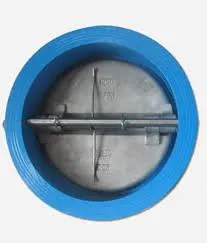
- Call Us
- +8618633052223
- njhdvlz@163.com
Sep . 19, 2024 00:04 Back to list
butterfly valve vs gate valve exporter
Comparing Butterfly Valves and Gate Valves Features and Applications
In the fluid control industry, valves play a crucial role in regulating the flow of liquids and gases. Among the various types of valves, butterfly valves and gate valves are two commonly used options. Each has unique characteristics, advantages, and ideal applications, making it essential for engineers and decision-makers to understand their differences.
Butterfly Valves
Butterfly valves are quarter-turn valves featuring a disc that rotates around a central axis. When the valve is open, the disc is parallel to the flow, allowing for efficient fluid passage. Closing the valve involves rotating the disc perpendicular to the flow, effectively blocking it.
One of the primary advantages of butterfly valves is their compact design, making them suitable for installations with limited space. They are lightweight and easy to operate, often requiring less force to open and close compared to other valve types. Additionally, butterfly valves can handle a wide range of temperatures and pressures, making them versatile for various applications, including water supply, wastewater treatment, and chemical processing.
Gate Valves
butterfly valve vs gate valve exporter

Gate valves, on the other hand, are linear motion valves that use a gate-like mechanism to control flow. When fully open, the gate retracts into the valve body, allowing for minimal resistance against the flow. However, when closed, the gate creates a tight seal, preventing any fluid from passing through.
The primary advantage of gate valves is their ability to provide a straight-through flow path, which results in minimal pressure drop. This makes them ideal for applications where full flow is required, such as in large pipelines or systems where high flow rates are essential. Gate valves are also known for their durability and ability to withstand high pressures and temperatures, making them a popular choice in oil and gas pipelines, power plants, and fire protection systems.
Key Differences
When choosing between butterfly and gate valves, there are several key differences to consider. Butterfly valves excel in tight spaces and provide quick operation, whereas gate valves are better suited for applications requiring unobstructed flow. Additionally, butterfly valves generally have a lower cost and can be easier to maintain, while gate valves tend to offer a better seal when closed.
Conclusion
In summary, both butterfly valves and gate valves serve specific purposes in fluid control applications. Butterfly valves are favored for their compact design and quick operation, while gate valves are preferred for their ability to provide a straight-flow path and durability. Understanding these differences will help engineers make informed decisions when selecting the appropriate valve for their projects, ultimately leading to more efficient and reliable systems.
-
Stainless Steel Sanitary Butterfly Valve | Hygienic & Durable
NewsAug.02,2025
-
Double Flanged Short Pattern Butterfly Valve | Compact, Efficient Flow
NewsAug.01,2025
-
Precise 3-Inch Butterfly Valve Dimensions | Durable Flow
NewsJul.31,2025
-
3 Butterfly Valve Dimensions | GPT-4 Turbo Precision Specs
NewsJul.31,2025
-
Stainless Steel Sanitary Butterfly Valve for Hygienic Flow Control
NewsJul.30,2025
-
High-Performance Groove Butterfly Valve for Easy Installation
NewsJul.30,2025